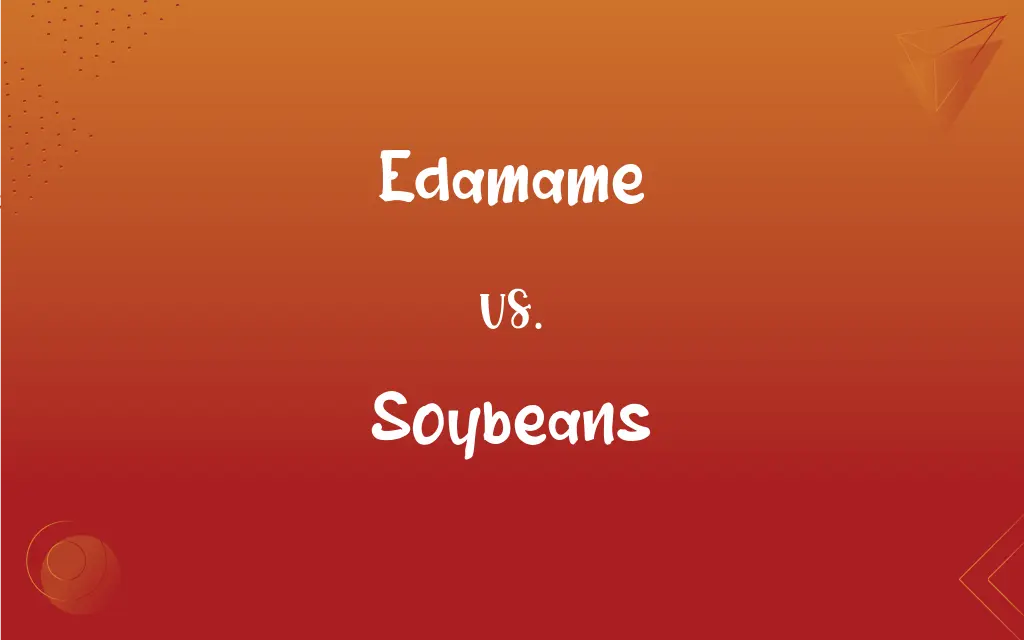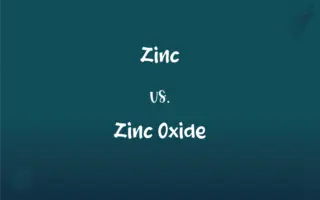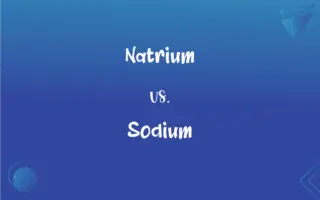Edamame vs. Soybeans: What's the Difference?
Edited by Janet White || By Harlon Moss || Published on December 31, 2023
Edamame are young, green soybeans, typically eaten steamed or boiled, whereas soybeans are mature beans used in various products like tofu and soy milk.

Key Differences
Edamame, harvested while green and tender, is popular as a snack or appetizer, often served in pods and lightly salted. Soybeans, harvested when mature and dried, are processed into various foods like tofu, tempeh, and soy milk, showcasing their versatility in cooking.
Edamame, rich in protein and fiber, also contains vitamins like Vitamin K. Soybeans, in their mature form, are a powerhouse of protein and contain essential amino acids, making them a staple in vegetarian diets.
Edamame is harvested earlier than soybeans, ensuring their soft, edible pods. Soybeans are left on the plant until they reach maturity and dry out, making them suitable for a wide range of processed products.
Edamame, often associated with East Asian cuisine, is a popular appetizer in Japanese and Chinese restaurants. Soybeans have a global presence, being integral to many cultural dishes and used extensively in alternative dairy products and meat substitutes.
Edamame is typically boiled or steamed and eaten directly from the pod. Soybeans undergo various processing methods, like grinding, fermenting, and pressing, to produce different food products, demonstrating their adaptability in the food industry.
ADVERTISEMENT
Comparison Chart
Stage of Harvest
Harvested young and green
Harvested when mature and dry
Usage in Cuisine
Eaten as a snack or appetizer
Processed into foods like tofu and milk
Nutritional Content
High in vitamins and fiber
Rich in protein and essential amino acids
Texture and Taste
Tender and slightly sweet
Harder texture, neutral taste
Cultural Association
Associated with East Asian cuisine
Used globally in various cuisines
ADVERTISEMENT
Edamame and Soybeans Definitions
Edamame
A nutritious snack, typically salted and eaten directly from the pod.
Edamame makes for a healthy and delicious snack on movie nights.
Soybeans
Beans that can be processed into oil, milk, and meat substitutes.
Soybeans are versatile; you can even make milk out of them.
Edamame
Immature soybeans in pods, commonly found in East Asian cuisine.
She added edamame to her salad for extra protein.
Soybeans
Often used in animal feed and industrial products.
Apart from human consumption, soybeans are also used in animal feed.
Edamame
Green soybeans harvested early for their soft texture.
I prefer edamame over other snacks because of its fresh taste.
Soybeans
A staple legume in many diets, especially for their protein content.
Soybeans are a crucial ingredient in vegetarian diets.
Edamame
A young, green variety of soybeans, often served steamed.
We ordered a bowl of edamame as an appetizer.
Soybeans
Mature beans used in a variety of food products like tofu and soy milk.
Soybeans are essential for making tofu.
Edamame
Often used in vegetarian dishes for its high protein content.
The vegan sushi roll includes edamame and avocado.
Soybeans
Cultivated globally, known for their environmental sustainability.
Farmers are increasingly growing soybeans due to their high demand.
Edamame
Fresh green soybeans boiled as a vegetable.
Soybeans
An annual leguminous plant (Glycine max) native to East Asia, widely cultivated for its seeds, which are used for food, as a source of oil, and as animal feed.
Soybeans
A seed of this plant.
Soybeans
Plural of soybean
FAQs
Can you eat edamame raw?
It's not recommended; edamame is usually cooked to enhance flavor and digestibility.
How do you cook edamame?
Edamame is typically boiled or steamed and served with salt.
What products are made from soybeans?
Soybeans are used to make tofu, soy milk, tempeh, and soy sauce, among others.
Is edamame a good source of protein?
Yes, edamame is high in protein and makes a great vegetarian protein source.
Are soybeans and edamame the same?
No, soybeans are mature beans, while edamame is the young, green version.
Is edamame a common allergen?
Yes, as a soy product, edamame can be an allergen for some individuals.
Is edamame high in fiber?
Yes, edamame is a good source of dietary fiber.
What is edamame?
Edamame are young, green soybeans often eaten steamed or boiled.
Are soybeans good for health?
Yes, soybeans are rich in protein, fiber, and essential nutrients.
Can soybeans be eaten raw?
No, raw soybeans are hard and not easily digestible. They are usually cooked or processed.
How do you store edamame?
Edamame can be stored in the refrigerator or freezer, usually in its pods.
Can edamame be included in a keto diet?
In moderation, as edamame contains carbohydrates.
Can soybeans be used in baking?
Yes, soy flour made from soybeans is used in various baking recipes.
What is the protein content in soybeans?
Soybeans are very high in protein, making them a key ingredient in many plant-based diets.
How does the taste of soybeans differ from edamame?
Soybeans have a neutral, slightly nutty taste, while edamame is sweeter and more tender.
Can edamame help in weight loss?
Yes, its high protein and fiber content can aid in feeling full, thus helping with weight management.
Are soybeans environmentally sustainable?
Soybeans are considered more sustainable than some crops, but their cultivation can have environmental impacts.
Are soybeans GMO?
Many soybeans are genetically modified, although non-GMO varieties are also available.
Is edamame suitable for a vegan diet?
Yes, edamame is plant-based and suitable for vegans.
Are soybeans used in animal feed?
Yes, a significant portion of soybean production is used for animal feed.
About Author
Written by
Harlon MossHarlon is a seasoned quality moderator and accomplished content writer for Difference Wiki. An alumnus of the prestigious University of California, he earned his degree in Computer Science. Leveraging his academic background, Harlon brings a meticulous and informed perspective to his work, ensuring content accuracy and excellence.
Edited by
Janet WhiteJanet White has been an esteemed writer and blogger for Difference Wiki. Holding a Master's degree in Science and Medical Journalism from the prestigious Boston University, she has consistently demonstrated her expertise and passion for her field. When she's not immersed in her work, Janet relishes her time exercising, delving into a good book, and cherishing moments with friends and family.






































































